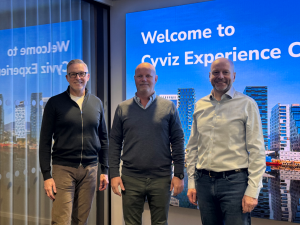Cyviz and Workplace Vision Announce Strategic Partnership
Cyviz, a global collaboration technology and platform provider, partners with Workplace Vision, a company transforming how global enterprises approach AV.
Cyviz Platform Becomes Part of a Global AV Standard
The partnership enables Workplace Vision to integrate the Cyviz Management & Monitoring Software Platform into its service offerings while incorporating Cyviz’ core solutions into their global AV standards portfolio.
Workplace Vision specializes in bridging the gap between AV and IT, partnering with major service providers to deliver consistent, enterprise-grade solutions worldwide.
With strategically located Global Operating Centers and 24/7 support capabilities, they serve some of the most demanding and complex environments across industries and geographies.
“This partnership is a great match. Workplace Vision shares our ambition to transform the AV industry with scalable, software-powered solutions. Their global reach and IT-centric approach make them an ideal partner to accelerate our platform strategy and deliver more value to enterprise customers”, says Espen Gylvik, CEO of Cyviz.
Enabling Recurring Revenues
Workplace Vision will leverage Cyviz’ software platform to offer real-time monitoring, predictive maintenance, data-driven insights, and multi-site management capabilities, enabling them to create tailored managed services and recurring revenue models.
The companies aim to address large organizations' growing demand for standardized, easy-to-manage AV environments.
“The Cyviz team has been agile and easy to work with, and their management platform adds considerable value to our service proposition and has been very well received by our clients”, says John Masters, CEO of Workplace Vision.
A Key Milestone in Cyviz’ Global Partner Strategy
This partnership is part of Cyviz’ broader strategy to scale its software and platform offering through a growing global network of partners. With over 15 partner agreements signed to date, this collaboration marks a significant milestone as the company’s new business line gains traction and moves toward global adoption.
Meylin Loo
Cyviz
+47 458 65 411
email us here
Legal Disclaimer:
EIN Presswire provides this news content "as is" without warranty of any kind. We do not accept any responsibility or liability for the accuracy, content, images, videos, licenses, completeness, legality, or reliability of the information contained in this article. If you have any complaints or copyright issues related to this article, kindly contact the author above.
SoftwareWorld Now Provides Reputation-Based Short Reviews for All Popular Software Tools
Mobility City of Chicago IL Provides Fast, Trusted Mobility Equipment Repair Services for Veterans Across Chicagoland
Mobility City of New Orleans Provides Veterans with Mobility Equipment Repair Service Completed in Under Five Days
Więcej ważnych informacji
 Jedynka Newserii
Jedynka Newserii

 Jedynka Newserii
Jedynka Newserii

Problemy społeczne

Sukces gospodarczy Polski może zachęcić do powrotów Polaków mieszkających za granicą. Nowa rządowa strategia ma w tym pomóc
Polska coraz mocniej stawia na powroty swoich obywateli z zagranicy. Rządowa strategia współpracy z Polonią na najbliższe lata zakłada system zachęt dla osób powracających, ale też ułatwienia w uznawaniu wykształcenia i kwalifikacji, podejmowaniu studiów czy staży zawodowych. To w obliczu rosnących wyzwań demograficznych i zapotrzebowania na wysoko wykwalifikowaną kadrę szansa na wzmocnienie rynku pracy. Napływ wykwalifikowanych specjalistów z doświadczeniem zdobytym za granicą może pomóc w modernizacji krajowej gospodarki.
Prawo
ZPP: Działania administracji narażają na szwank wysiłek deregulacyjny. Niektóre niosą znamiona dyskryminacji i nękania przedsiębiorców

Choć rząd zgodnie z zapowiedziami realizuje szeroko zakrojone zmiany deregulacyjne, przedsiębiorcy alarmują, że brakuje w nich spójności, przewidywalności i realnej poprawy, zwłaszcza w kontaktach z administracją. Jako przykład ZPP podaje przypadek firmy British American Tobacco (BAT) i jej zatrzymanego przez izbę celno-skarbową zamówienia 200 tys. kartridży do e-papierosów. Dotknięte tą decyzją spółki liczą straty.
Konsument
Branża piwowarska dodaje do polskiej gospodarki ponad 20,5 mld zł rocznie. Spadki sprzedaży i produkcji piwa uderzają również w inne sektory

Branża piwowarska pozostaje ważnym ogniwem polskiej gospodarki. Nowy raport CASE wskazuje, że generuje ona 3 proc. dochodów budżetowych i 85 tys. miejsc pracy w samych browarach i innych powiązanych sektorach. Dlatego kurczący się rynek piwa może mieć poważne reperkusje – już dziś nadwyżka mocy produkcyjnych przekracza 10 mln hl. Spadki są spowodowane m.in. znaczącym wzrostem kosztów działalności, spadkiem konsumpcji, a także uderzającymi w browarników zmianami regulacyjnymi.
Partner serwisu
Szkolenia

Akademia Newserii
Akademia Newserii to projekt, w ramach którego najlepsi polscy dziennikarze biznesowi, giełdowi oraz lifestylowi, a także szkoleniowcy z wieloletnim doświadczeniem dzielą się swoją wiedzą nt. pracy z mediami.









.gif)

 |
| |
| |
|